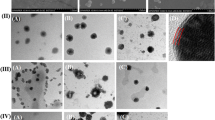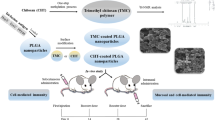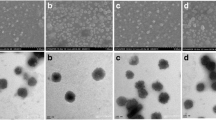Abstract
Purpose. Aim of the study was the evaluation of the potential of novel tetanus toxoid (TT) loaded nanoparticles (NP) for electing an immune response in mice against TT.
Methods. Six week-old female Balb/c mice were immunized by oral (p.o.), nasal (i.n.) and intraperitoneal (i.p.) application of TT NP loaded by adsorption. As polymer a novel polyester, sulfobutylated poly(vinyl alcohol)-graft-poly(lactide-co-glycolide), SB(43)-PVAL-g-PLGA was used. Blood samples were collected 4 and 6 weeks after immunization and assayed for serum IgG- as well as IgA antibody titers by ELISA. NP formulations varying in size and loading were compared to alum adsorbates as well as to TT solutions.
Results. Both, p.o. and i.n. administration of TT associated NP increased serum titers up to 3 × 103 (IgG) and 2 × 103 (IgA). While small NP induced significantly higher titers then larger ones after oral administration, intermediate NP induced antibodies after nasal application. Of the mucosal routes investigated, i.n. seems to be more promising compared to p.o. immunization.
Conclusions. Antigen loaded NP prepared from surface modified polyesters combined with CT show considerable potential as a vaccine delivery system for mucosal immunization. The results warrant further experiments to explore in more detail the potential use of NP as mucosal vaccine delivery system.
Similar content being viewed by others
REFERENCES
M. E. Lamm. Interaction of antigens and antibodies at mucosal surfaces. Ann. Rev. Microbiol. 51:311-340 (1997).
M. R. Neutra, E. Pringault, and J. P. Kraehenbuhl. Antigen sampling across epithelial barriers and induction of mucosal immune responses. Ann. Rev. Immunol. 14:275-300 (1996).
M. Isaka, Y. Yasuda, S. Kozuka, Y. Miura, T. Taniguchi, K. Matano, N. Goto, and K. Tochikubo. Systemic and mucosal immune responses of mice to aluminium-adsorbed or aluminium-non-adsorbed tetanus toxoid administered intranasally with recombinant cholera toxin B subunit. Vaccine 16:1620-1626 (1998).
A. T. Florence. The oral absorption of micro-and nanoparticulates: Neither exceptional nor unusal. Pharm. Res. 14:259-266 (1997).
M. D. Donovan and H. Ye. Large molecule and particulate uptake in the nasal cavity: The effect of size on nasal absorption. Adv. Drug Deliv. Rev. 29:147-155 (1998).
H. O. Alpar, J. E. Eyles, and E. D. Williamson. Oral and nasal immunization with microencapsulated clinically relevant proteins. S.T.P. Pharm. Sci. 8:31-39 (1998).
T. Jung, A. Breitenbach, and T. Kissel. Sulfobutylated poly(vinyl alcohol)-graft-poly(lactide-co-glycolides) facilitates the preparation of small negatively charged biodegradable nanospheres for protein delivery. J. Control. Release 67:157-169 (2000).
W. Norde and J. Lyklema. The adsorption of human plasma albumin and bovine pancreas ribonuclease at negatively charged polystyrene surfaces (I. Adsorption isotherms. Effect of charge, ionic strength, and temperature). J. Colloid. Interface Sci. 66:257-265 (1978).
W. Norde. Adsorption of proteins from solution at the solid-liquid interface. Adv. Col. Interf. Sci. 25:267-340 (1986).
A. J. Almeida, H. O. Alpar, and M. R. Brown. Immune response to nasal delivery of antigenically intact tetanus toxoid associated with poly(L-lactic acid) microspheres in rats, rabbits and guinea-pigs. J. Pharm. Pharmacol. 45:198-203 (1993).
R. I. Walker. New strategies for using mucosal vaccination to achieve more effective immunization. Vaccine 12:387-400 (1994).
T. B. Tomasi. Oral tolerance. Transplantation 29:353-356 (1980).
C. O. Elson and W. Ealding. Cholera toxin feeding did not induce oral tolerance in mice and abrogated oral tolerance to an unrelated protein antigen. J. Immunol. 133:2892-2897 (1984).
R. J. Jackson, H. F. Staats, J. Xu-Amano, I. Takahashi, H. Kiyono, M. E. Hudson, R. M. Gilley, S. N. Chatfield, and J. R. McGhee. Oral vaccine models: multiple delivery systems employing tetanus toxoid. Ann. N. Y. Acad. Sci 730:217-234 (1994).
T. Uchida and S. Goto. Oral delivery of poly(lactide-co-glycolide) microspheres containing ovalbumin as vaccine formulation: particle size study. Biol. Pharm. Bull. 17:1272-1276 (1994).
Y. Tabata, Y. Inoue, and Y. Ikada. Size effect on systemic and mucosal immune response induced by oral administration of biodegradable microspheres. Vaccine 14:1677-1685 (1996).
D. H. Jones, B. W. McBride, C. Thornton, D. T. O. Hagan, A. Robinson, and G. H. Farrar. Orally administered microencapsulated Bordetella pertussis fimbriae protect mice from B. pertussis respiratory infection. Infect. Immun. 64:489-494 (1996).
J. Holmgren, P. Brantzaeg, A. Capron, M. Francotte, M. Kilian, J. P. Kraehenbuhl, T. Lehner, and R. Seljelid. European Commission COST/STD Initiative. Report of the expert panel VI. Concerted efforts in the field of mucosal immunology. Vaccine 14:644-664 (1996).
P. Jani, G. W. Halbert, J. Langridge, and T. Florence. The uptake and translocation of latex nanospheres and microspheres after oral administration to rats. J. Pharm. Pharmacol. 41:809-812 (1989).
P. U. Jani, G. W. Halbert, J. Langridge, and A. T. Florence. Nanoparticle uptake by the rat gastrointestinal mucosa: Quantitation and particle size dependency. J. Pharm. Pharmacol. 42:821-826 (1990).
J. H. Eldridge, R. M. Gilley, J. K. Staas, Z. Moldoveanu, J. A. Meulbroek, and T. R. Tice. Biodegradable microspheres: Vaccine delivery system for oral immunization. Curr. Top. Microbiol. Immunol. 146:59-66 (1989).
S. J. Challacombe, D. Rahman, and D. T. O. Hagan. Salivary, gut, vaginal and nasal antibody responses after oral immunization with biodegradable microparticles. Vaccine 15:169-175 (1997).
J. S. Patton. Mechanisms of macromolecule absorption by the lungs. Adv. Drug Del. Rev. 19:3-36 (1996).
Y. Kubota, S. Takahashi, and O. Matsuoka. Dependence on particle size in the phagocytosis of latex particles by rabbit alveolar macrophages cultured in vitro. J. Toxicol. Sci. 8:189-195 (1983).
T. Verrecchia, P. Huve, D. Bazile, M. Veillard, G. Spenlehauer, and P. Couvreur. Adsorption/desorption of human serum albumin at the surface of poly(lactic acid) nanoparticles prepared by a solvent evaporation process. J. Biomed. Mater. Res. 27:1019-1028 (1993).
A. J. Almeida and H. O. Alpar. Nasal delivery of vaccines. J. Drug Target. 3:455-467 (1996).
J. H. Eldridge, C. J. Hammond, J. A. Meulbroek, J. K. Staas, R. M. Gilley, and T. R. Tice. Controlled vaccine release in the gut-associated lymphoid tissues—Orally administered biodegradable microspheres target the Peyer's patches. J. Control. Release 11:205-214 (1990).
M. A. Jepson, N. L. Simmons, D. T. O. Hagan, and B. H. Hirst. Comparison of poly(DL-lactide-co-glycolide) and polystyrene microsphere targeting to intestinal M cells. J. Drug Target. 1:245-249 (1993).
Author information
Authors and Affiliations
Rights and permissions
About this article
Cite this article
Jung, T., Kamm, W., Breitenbach, A. et al. Tetanus Toxoid Loaded Nanoparticles from Sulfobutylated Poly(Vinyl Alcohol)-Graft-Poly(Lactide-co-Glycolide): Evaluation of Antibody Response After Oral and Nasal Application in Mice. Pharm Res 18, 352–360 (2001). https://doi.org/10.1023/A:1011063232257
Issue Date:
DOI: https://doi.org/10.1023/A:1011063232257




